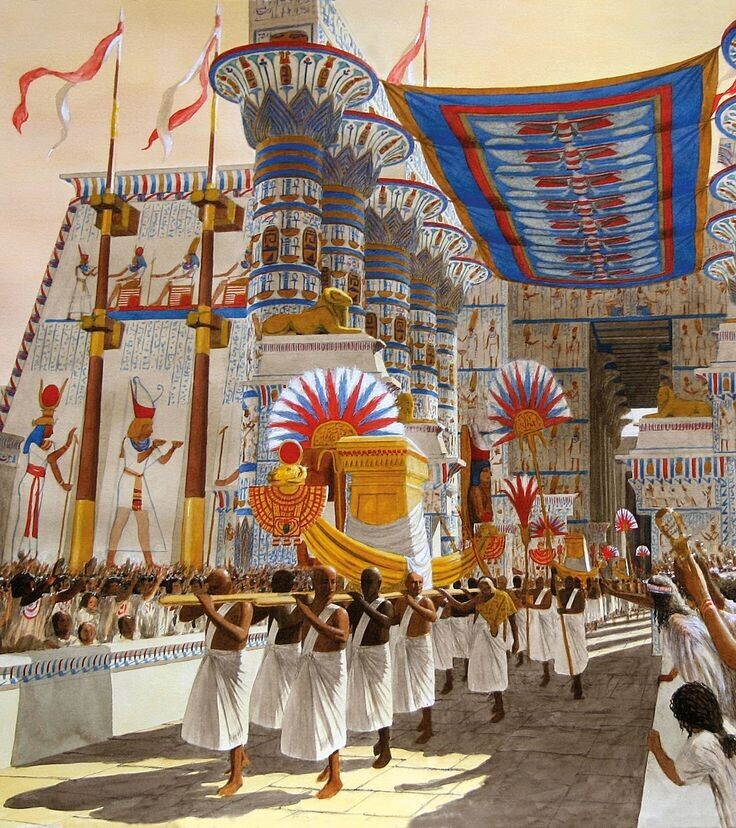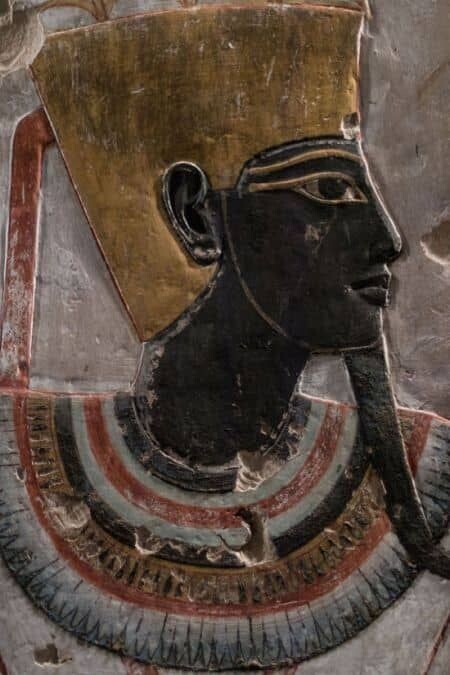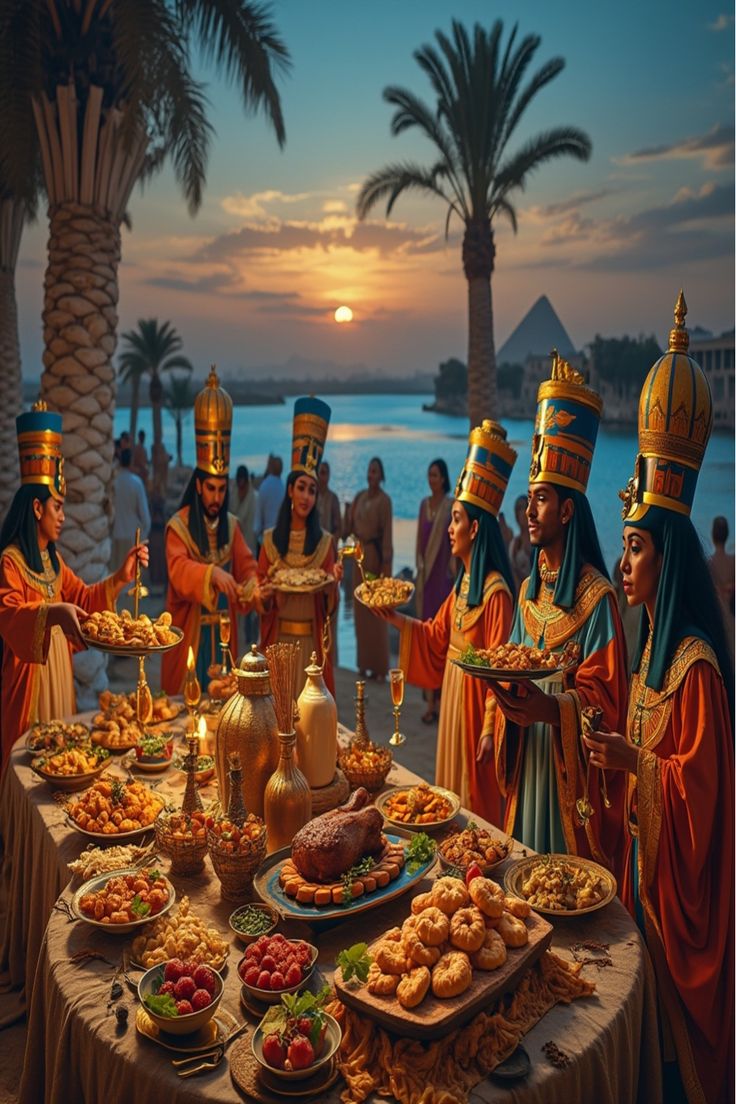Imagine walking through the bustling streets of Ancient Thebes, where the air is filled with excitement and anticipation. Vibrant colors, intoxicating aromas, and the sound of music fill the space as citizens eagerly prepare for one of their grandest celebrations. Celebrations in Ancient Egypt weren’t just mere festivities; they were a vital component of daily life, intricately woven into the society’s fabric.
Festivals in Ancient Egypt were far more than social events. They reflected a profound connection to the cosmos, the rhythms of the Nile, and the deities they revered.
With each festival, the Egyptians reinforced bonds within their community, ensuring that everyone, from the pharaoh to the farmer, felt their place in the grand tapestry of their civilization. These moments of joy provided structure and meaning to their year and brought a sense of order and stability.
In this exploration, you will discover how these ancient festivities served as pivotal occasions for expressing religiosity, sharing agricultural prosperity, and celebrating the pharaohs who ruled as gods on earth.
The Opet Festival: Honoring Divine Kingship and Fertility
Imagine the vibrant streets of Ancient Thebes during the Opet Festival, one of the year’s most anticipated events. This festival, crucial to reinforcing the pharaohs’ divine right to rule, intersected neatly with the agricultural belief in land fertility. Statues of key deities Amun, Mut, and Khonsu journeyed majestically from the colossal Karnak to the elegant Luxor Temple along an avenue dotted with sphinxes. It was a potent symbol of divine and royal rebirth that captivated the entire city.

During this festival, the pharaoh enacted rituals that were believed to rejuvenate his strength and, by extension, the vitality of the land itself. At its heart, the festival was a dazzling spectacle of music and dance, with priests performing sacred rites intended to secure the gods’ favor for the coming year. Food and drink flowed freely as the populace indulged in a communal celebration, reinforcing the social bonds that held the community together.
A notable aspect of the Opet Festival was the inclusivity of the event. Though rooted in divine and royal symbolism, it wasn’t just an elite affair. Everyone from high-ranking officials to common folk shared in the feasting and entertainment. This accessibility reflects the importance of making these rites visible and participatory to the public, an affirmation of the shared values and unity of Egyptian society.
The Sed Festival: Pharaoh’s Triumphant Jubilee
The Sed Festival stands as one of the most intriguing celebrations from Ancient Egyptian times. This was not just any festival; it marked a milestone denoting the pharaoh’s 30 years on the throne. It was designed to rejuvenate the pharaoh’s rule and underscore the divine legitimacy of his kingship.
For the Egyptians, the vitality of the pharaoh was directly tied to the prosperity of the nation. The main ritual involved a symbolic race where the pharaoh showcased his physical stamina to prove he was still fit to lead his people. By successfully completing the ritual run, the pharaoh was believed to be refreshed, having demonstrated his unwavering strength and divine right to continue in power.
Alongside this display of vigor, the queendoms would give offerings to the gods, recognizing their eternal support. The intent was to reinforce the sacred bond between the pharaoh, his people, and the multitude of deities that presided over the land of Egypt. It was a moment of unity and recommitment to the cosmic order that ordered their world.
The Sed Festival went beyond the ceremonial acts of the pharaoh; it touched the lives of ordinary citizens. The festivities were a national event, with music and dancing permeating the air, and a wide array of feasts that brought communities together. For Egyptians, communal participation in such events reinforced social ties and the collective acknowledgment of the pharaoh’s renewed powers.
The Beautiful Feast of the Valley: A Communion with the Ancestors
The Beautiful Feast of the Valley was more than just a lively annual event; it was a heartfelt tribute to those who had passed on. This festival took place in Thebes, modern-day Luxor, where the living would venture to the west bank to honor their ancestors, reinforcing the bond between the nexuses of life and the afterlife.
Central to this event was the deity Amun, revered not just as a king of gods but as a bridge connecting the verdant east bank of living Thebes with its solemn necropolis on the west. In a grand procession, Amun’s statue, along with those of other local deities, journeyed from the temple complex at Karnak to the west bank. This visually striking move symbolized the gods visiting the resting places of the departed, blessing them anew.

The celebration was a time of community and reflection. Families prepared sumptuously, bringing food and drink to share amongst each other at the tombs of their forebears. It was common to see throngs of people carrying offerings, their faces solemn yet content, perhaps in the understanding that this festival was not just about remembrance but also about the cycle of life and hope for their journey in the afterlife.
This emphasis on renewal and rebirth found resonance in every aspect of the festival. It was a chance for people to express a deep and abiding connection with those who had crossed into the next world, embracing the permanence of legacy over the transience of mortal life.
As the day gave way to evening, and the celebrants prepared to leave the necropolis, the unity experienced during the Beautiful Feast of the Valley persisted, with hearts and spirits lifted. It was this unity that naturally flowed into the preparation for the Festival of Min, which highlighted the importance of fertility and harvest to sustenance and life.
The Festival of Min: Celebrating Abundance
The Ancient Egyptians held the Festival of Min with high regard, primarily because it affirmed the continuation of life through fertility and a bountiful harvest. Min, the god of fertility and harvest, stood at the center of these celebrations, symbolizing the potential for growth and renewal inherent in nature’s cycle.
The festivities took place during the harvest season when the granaries were full, underscoring the community’s collective bounty. Central to this festival was a grand procession, where the statue of Min was paraded before the people. Priests performed rituals and made offerings to invoke Min’s blessings, seeking to ensure the land’s continued fecundity and the people’s prosperity.

Beyond the religious ceremonies, the Festival of Min opened up a space for public celebration. Egyptians from all walks of life participated in music and dancing, turning the event into a widespread communal gathering. These activities not only solidified societal bonds but also allowed individuals to express their joy for the successful harvest season.
As the Festival of Min came to a close, thoughts naturally turned to the cycles of life and the essential relationship between humankind and the land. This transitioned neatly into reflections on the upcoming seasonal festivals, which similarly honored agricultural abundance and the deities safeguarding the cycles of growth and harvest.
Seasonal Festivities: Inundation and Harvest
Ancient Egyptian society was closely tied to the rhythms of the Nile River. The river’s flooding was not only vital for agriculture but also a cause for celebration. The Inundation Festival was a key event that marked the annual flooding of the Nile, a phenomenon Egyptians credited with bringing fertility and life to their lands. Hapi, the god representing the inundation of the Nile, was at the center of this festival. Communities would come together, offering gratitude to Hapi with hopes of ensuring a bountiful flood, which in turn meant a prosperous year ahead for everyone.
The celebrations during this time were not solely about paying tributes to the gods but also about reinforcing a sense of unity among the populace. Feasts and public gatherings encapsulated the spirit of this event, making it a true communal festivity. Music and storytelling were integral, with people sharing tales of past floods, which blended cultural heritage with practical agriculture practices.
Following the joyful deluge came the harvest festivals, which celebrated both the start and the end of the harvest season. These festivals were not only a time to give thanks for the yield but also to honor various agriculture-related deities. Among these, Renenutet, the goddess of the harvest and fertility, received special attention. The first fruits and grains were offered to the gods as a sign of gratitude, with the clear understanding that the divine’s favor was crucial for their sustenance.
The public celebrations of harvest festivals were vibrant and full of joy. Farmers and their families took pride in their hard work as they enjoyed music, dance, and feasting. It was a time when the fruits of labor were not only harvested but also shared, strengthening the fabric of the community and rejoicing in their collective efforts and blessings.
Preserving the Legacy: Reflections on Ancient Egyptian Festivities
The festivals of Ancient Egypt were more than mere dates on a calendar; they were essential threads woven into the societal fabric that held the civilization together. As we explore the complexities behind these symbolic celebrations, I’m struck by the depth of connection between the sacred and the mundane in Egyptian life.
Whether honoring fertility gods or paying homage to ancestral spirits, each festival carried a profound resonance for every Egyptian, from the pharaoh to the farmer. These events were the heartbeat of a civilization, pulsating with the themes of life, death, and rebirth, rooted in the perpetual cycles of the Nile and the heavens above.
Today, remnants of those grand celebrations exist in our own cultural festivities, echoing the ancient world’s understanding of the cosmos and human life. Each time we gather to commemorate our traditions, we’re participating in a legacy that dates back millennia, touching on the universal need for renewal and community.
In honoring the deities, affirming kingship, and lovingly tending to the memories of those who came before them, the Egyptians taught us that celebration is an art that reinforces communal bonds and assures the continuity of culture. It’s my hope that the values inherent in these ancient festivals — unity, reverence, and joyous participatory life — continue to inspire us today.

